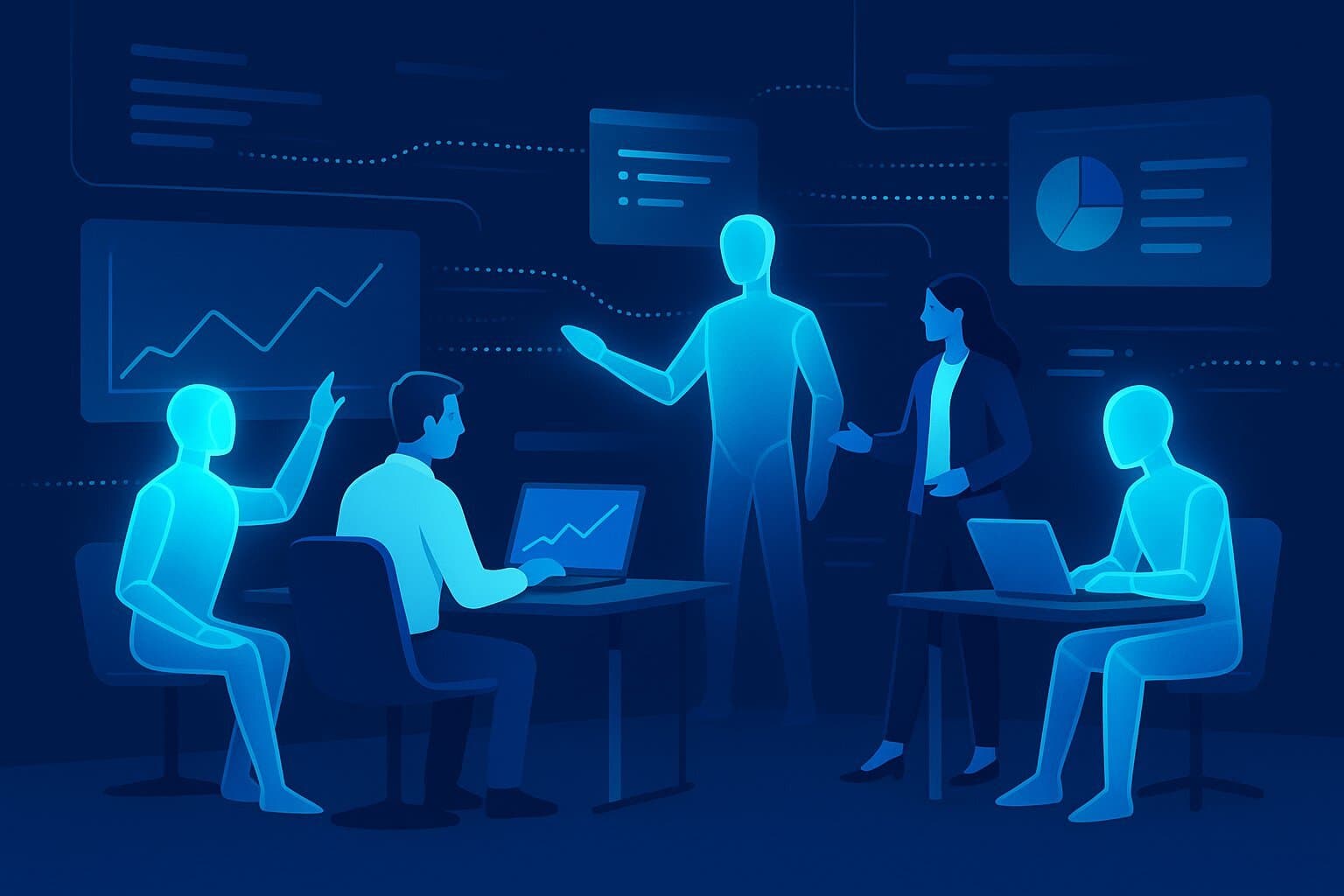
Microsoft AutoGen: A Practical Executive Guide to AI Agents
November 04, 2025 / Bryan Reynolds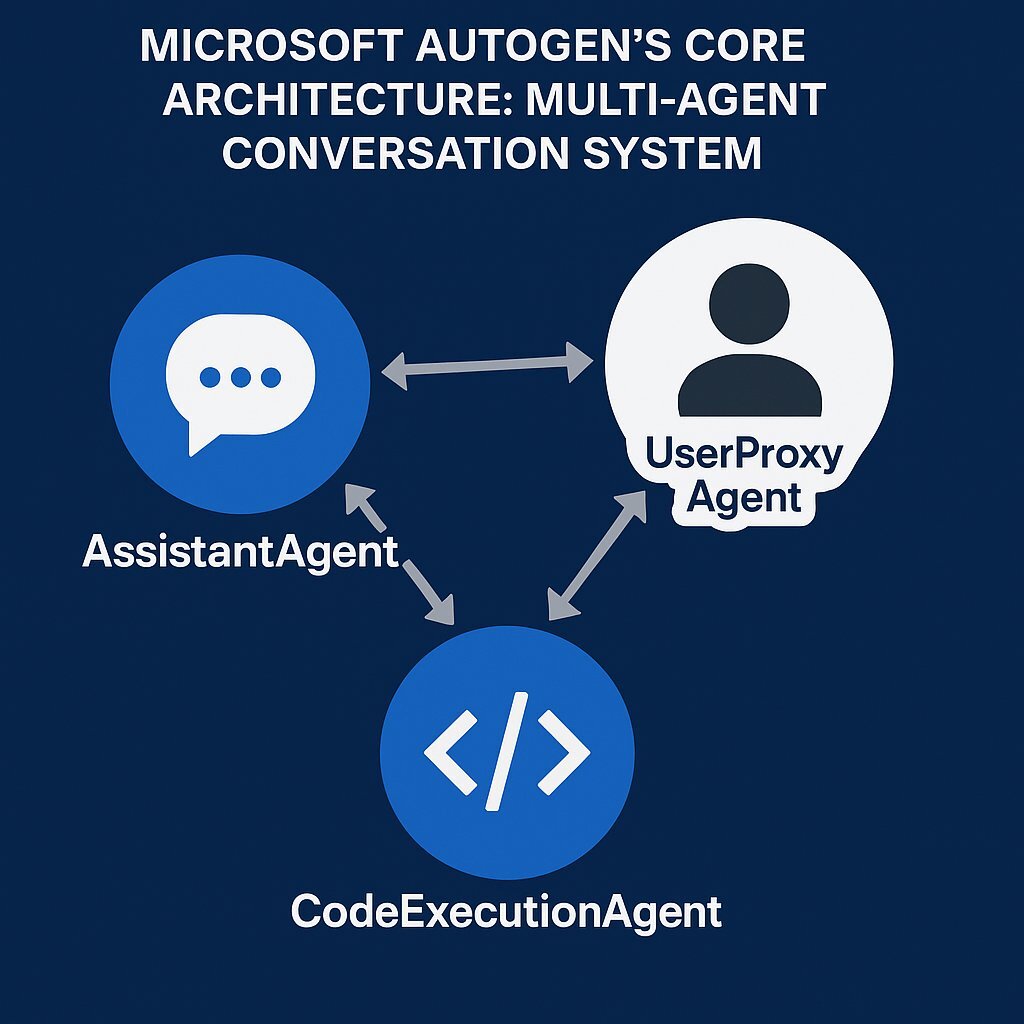
The buzz around AI agents is impossible to ignore. You've probably seen impressive demos of AI "teams" that build an entire app from a single prompt. But as a business leader, you have to separate the hype from the reality. You're asking the right questions: What is Microsoft AutoGen, really? How does it stack up against other frameworks? And what's the actual, bottom-line business case for it?
You're not just looking for a new tool; you're looking for a competitive advantage.
As a B2B technology analyst and content strategist—and part of a team at Baytech Consulting that lives and breathes enterprise-grade software—I've been in the trenches with these frameworks. The short answer is that AutoGen isn't just another chatbot. It's a powerful, open-source framework from Microsoft Research for building and orchestrating teams of AI agents that can collaborate, execute code, and even involve humans to solve complex problems.
Let's break down exactly what that means for you, how it compares to the alternatives, and where the real-world value lies.
What is Microsoft AutoGen, and How Does it Work?
At its core, AutoGen is a multi-agent conversation framework .
Think of it this way: most AI implementations feel like having a single, really smart intern. You give them a task, and they do their best.
AutoGen, by contrast, gives you a framework to build a whole department of specialists. You can create:
- An
AssistantAgent: This is your AI worker, powered by an LLM like GPT-4, designed to write code, analyze data, or draft a response. - A
UserProxyAgent: This is a critical component that acts as a proxy for a human . This agent can execute code, solicit human feedback, or provide approvals. This is what enables the "human-in-the-loop" workflow.
These agents "converse" with each other to solve a problem. For example, you could task a UserProxyAgent to "analyze last quarter's sales data from our PostgreSQL database and generate a report." The UserProxyAgent would then coordinate with an AssistantAgent (the "analyst") and a CodeExecutorAgent (the "developer"). The agents would debate the best approach, write Python code to query the database, execute it, debug any errors, and finally present the finished report to you for approval.
This entire process is powered by an asynchronous, event-driven architecture (introduced in the v0.4 redesign) that makes it more robust, scalable, and ready for enterprise applications.
How Does AutoGen Compare to Other AI Frameworks?
This is one of the most common questions from CTOs. The landscape is crowded, but the main players—AutoGen, CrewAI, and LangGraph (part of LangChain)—have very different philosophies.
- Microsoft AutoGen: The flexible, research-oriented "workshop." It's ideal for complex, exploratory tasks where the solution path isn't known. It excels at tasks that require code generation, execution, and self-correction. Its conversational-first approach is powerful but can be less predictable.
- CrewAI: The "assembly line." It's built for highly structured, role-based workflows where the process is already defined. It's known for being easier to start with and is great for automating known business processes (e.g., "Take this blog post, have an editor agent review it, then send it to a social media agent").
- LangGraph: The "engineering toolkit." As an extension of LangChain, LangGraph provides maximum control by forcing you to define all agentic workflows as a graph (nodes and edges). This offers reliability and durability but comes with a much steeper learning curve.
Here's a simple breakdown for your team:
| Framework | Core Philosophy | Best For... | Learning Curve |
|---|---|---|---|
| Microsoft AutoGen | Conversational & flexible. Agents collaborate in "chats" to find a solution. | Complex, exploratory R&D; autonomous code generation & debugging; tasks with unknown steps. | Moderate. The new AutoGen Studio (a low-code UI) makes it much easier to start. |
| CrewAI | Role-based & sequential. Agents follow a defined, hierarchical process. | Automating known, repeatable business processes; rapid prototyping of role-based teams. | Low. Very beginner-friendly and documentation is strong. |
| LangGraph (LangChain) | Graph-based & explicit. You define every possible state and transition. | Production-grade, durable workflows where you need 100% control over the execution path. | High. Requires thinking in graphs; best for existing LangChain users. |

The analyst's take: Choose CrewAI if you know exactly how to solve a problem and want to automate it. Choose AutoGen if you want a team of AI experts to figure out the solution for you.
Who is Using AutoGen, and What Are Its Primary Use Cases?
AutoGen has seen rapid adoption by researchers, developers, and, increasingly, enterprise teams. In a Microsoft Research presentation, data science leaders from Novo Nordisk (the pharmaceutical giant) shared that they are actively using AutoGen to develop a production-ready, multi-agent framework to help their broader community derive insights from technical data.
This signals a clear shift from academic experiment to real-world business tool.
For B2B firms in tech, finance, healthcare, and gaming, the use cases are powerful and map directly to your key departments:
- For Software & Tech (DevOps/R&D):
- Autonomous Code Generation: Agents can write, execute, and self-correct code to complete a programming task.
- Automated Debugging: You can build an agent that autonomously debugs live applications. A well-known example is an agent that uses
kubectlto diagnose and fix misconfigured deployments in a Kubernetes cluster. This is a game-changer for teams managing containerized microservices on platforms like Rancher .
- For Data Analysis & Finance (BI/Analytics):
- Complex Data Analysis: Agents can conduct a literature review, search ArXiv, query Google, and synthesize the results into a single report.
- Natural Language Database Querying: Agents can connect directly to your PostgreSQL or SQL Server databases, take a plain-English request (e.g., "Who were our top 5 clients by revenue last quarter?"), and write/execute the SQL query to get the answer.
- For Business Operations (Sales/Marketing/Ops):
- Supply Chain Optimization: Agents can be designed to model and optimize complex supply chains, a use case explicitly cited by Microsoft.
- Intelligent Customer Support: A multi-agent system can triage support tickets, have a retrieval agent search the knowledge base, a summarizer agent condense the findings, and a response agent draft the reply—all before a human support tech ever sees it.
What Are the Key Benefits of AutoGen for Your Business?
Let's translate these features into the specific value you and your executive team care about.
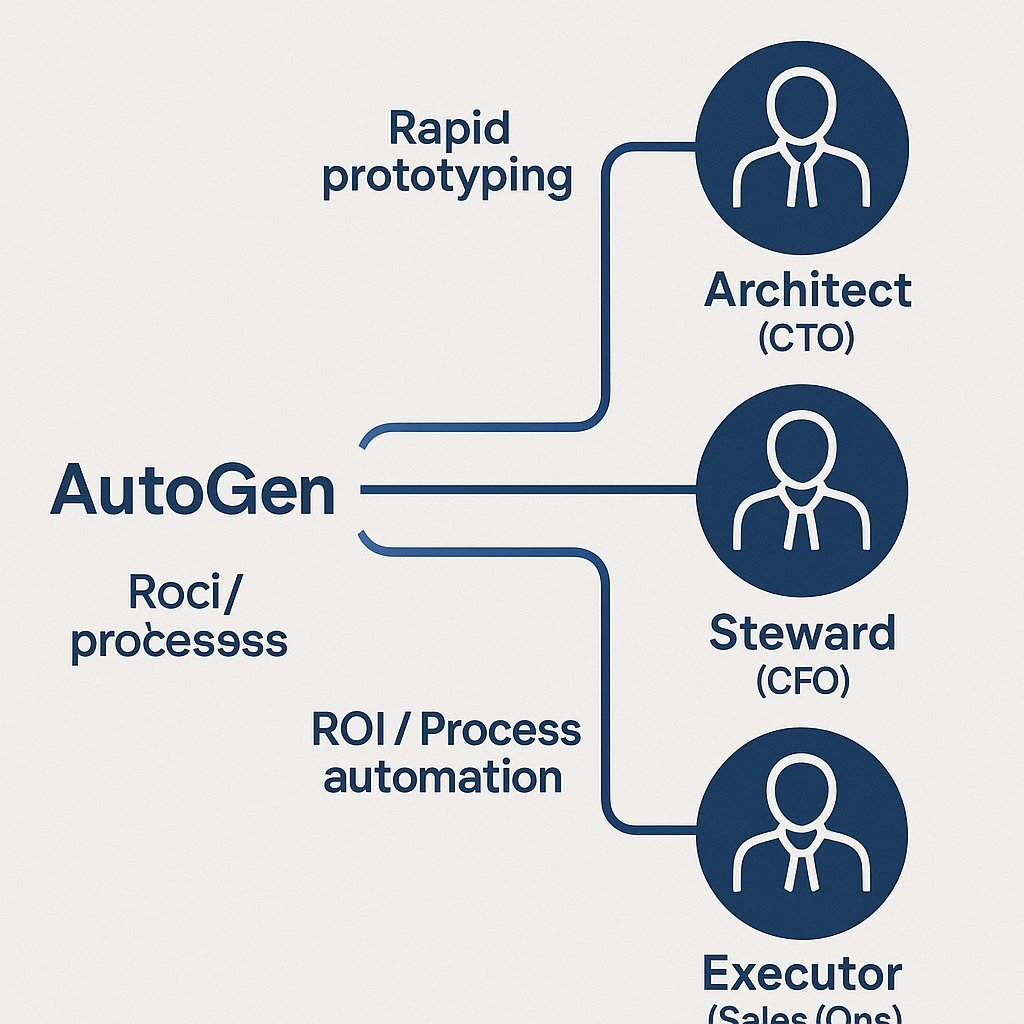
For the Visionary CTO (The Architect)
- Feature: AutoGen Studio & Database Integration.
- Benefit: Your team can move from idea to prototype at high speed. The Studio provides a low-code "what-you-see-is-what-you-get" interface to build and debug agent teams. More importantly, it features native connectors for PostgreSQL and Microsoft SQL Server . This means you can securely wire your agents to live business data from day one, not just play in a sandbox.
- Feature: Secure Code Execution & Deployment.
- Benefit: Agents can execute code, but safely. It integrates with secure code executors like Docker and can be deployed on Azure Container Apps or Kubernetes . This fits perfectly into your existing, secure Azure DevOps and container orchestration stack (like Rancher or Harvester HCI). Plus, its growing support for .NET means it integrates with your core Microsoft codebase.
For the Strategic CFO (The Steward)
- Feature: Automation of Complex, Multi-Step Workflows.
- Benefit: This is where you find the real ROI. We're moving from task automation (saving one person minutes) to process automation (saving an entire team days or weeks). The ROI is in automating high-friction processes like supply-chain optimization, financial reconciliation, or multi-source market research. This frees up your most expensive, high-value talent to focus on strategy, not repetitive coordination.
- Feature: Deep Microsoft Ecosystem Integration.
- Benefit: You are likely already a Microsoft enterprise customer. AutoGen is designed to work natively with Azure OpenAI . Its successor, the Microsoft Agent Framework, is being built for deep integration with Dynamics 365 , Microsoft 365 , and Azure AI Foundry . This reduces procurement friction, lowers total cost of ownership (TCO), and leverages your existing enterprise agreements.
For the Driven Head of Sales & Operations (The Executor)
- Feature: Robust Human-in-the-Loop (HIL) Workflows.
- Benefit: You can't let an AI "go rogue" with a client or a critical operation. AutoGen's HIL capability is a non-negotiable for enterprise-grade quality control. You can build a customer support team where an agent drafts a technical reply, but it must be approved by a human (via the
UserProxyAgent) before it's sent. - The Practical Workflow: The system is smart enough to handle asynchronous HIL. An agent team can complete a task, flag it for human review, and pause. A manager can then review the work in a web app or even Microsoft Teams and approve it, at which point the agent team resumes. This fits how real-world, high-stakes operations actually function.
The Honest Truth: Challenges and Limitations of AutoGen (And How to Address Them)
As part of our "They Ask, You Answer" approach, we have to be transparent. Based on our experience deploying complex systems, no platform is a silver bullet. A successful AutoGen implementation requires honestly addressing three key hurdles.
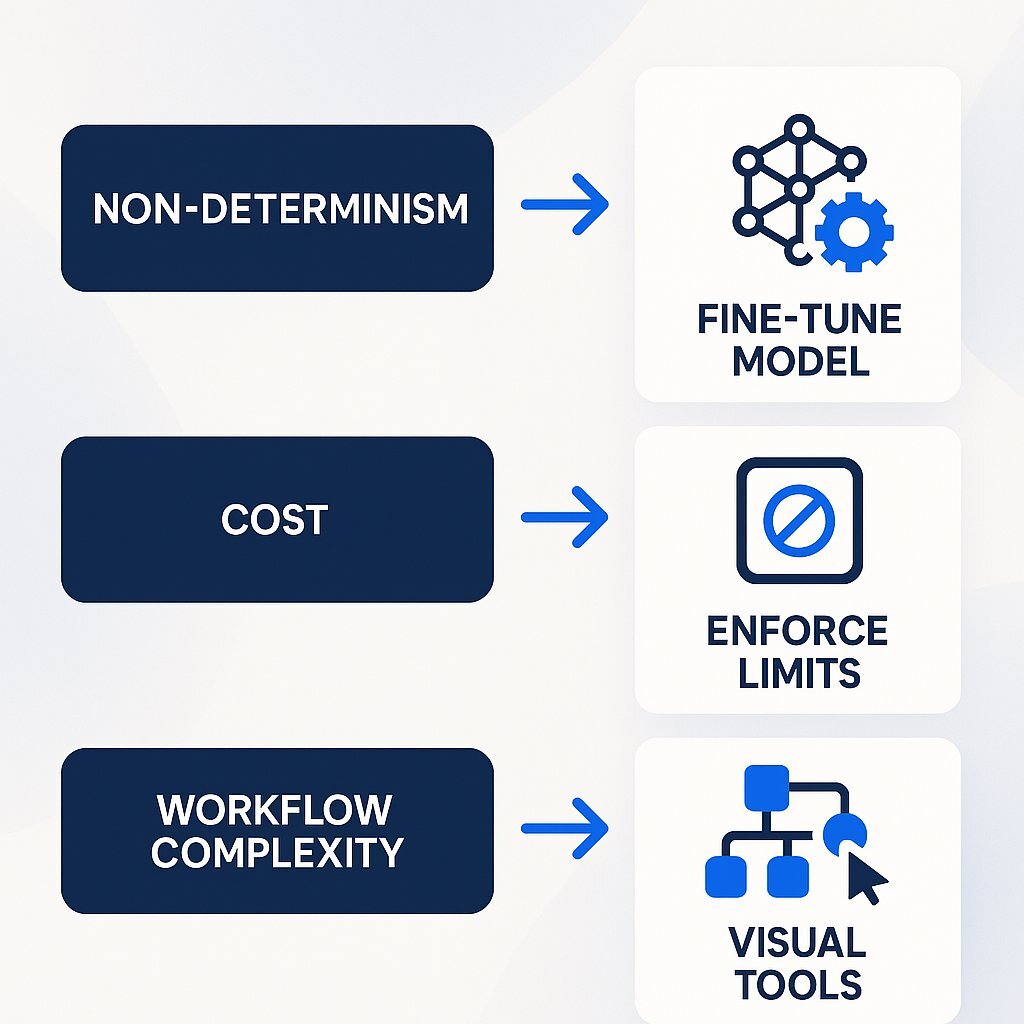
Challenge 1: Non-Determinism & Production Reliability
- The Problem: Agents are non-deterministic. The same prompt can trigger "wildly different multi-agent dialogues". This is an "exciting" experiment but "destroys production reliability". Debugging becomes nearly impossible, as community members have noted.
- The Solution: Engineer for Reliability.
- Control the Model: Set the LLM
temperatureto 0 to reduce randomness. - Log Everything: As recommended by production teams, you must "Capture and Archive Complete Conversation State" after every agent turn.
- Enable Replay: Use these archived snapshots for "On-Demand Replay" to reproduce and debug failures.
- Leverage v0.4: This is precisely why v0.4's built-in debugging tools and OpenTelemetry support are so critical. They provide the observability to manage this chaos.
- Control the Model: Set the LLM
Challenge 2: Spiraling API & Token Costs
- The Problem: A "team" of agents can become very "chatty". They can get stuck in debate loops or make excessive tool calls, "racking up API costs" before you even notice.
- The Solution: Implement Strict Cost Guardrails.
- Monitor Proactively: AutoGen Studio includes a profiler to view "costs associated with the run (such as number of turns and number of tokens)". Use this obsessively in development.
- Enforce Limits: Programmatically set limits (like
max_consecutive_auto_reply) to break loops and require human intervention. - Use Tiered Models: Don't use GPT-4o for everything. Use a "manager" agent to route simple tasks to cheaper, faster models (which AutoGen supports).
- The Human Circuit-Breaker: A Human-in-the-Loop is the ultimate cost-control, stepping in to stop a runaway process.
Challenge 3: Debugging & Workflow Complexity
- The Problem: The initial release of AutoGen was notoriously difficult to debug. A multi-agent conversation is a complex, emergent system. Finding the one bad prompt or faulty logic in a 20-step agent conversation can be a nightmare.
- The Solution: Use the Right Tools.
- AutoGen Studio: This is the "easy button." It provides a "low-code interface" and "visual representation of message flow" to help you see the interactions, not just read a console log.
- Observability Stack: This is the business value of v0.4's OpenTelemetry support. It allows you to trace agent interactions in enterprise monitoring tools like Azure Monitor, Datadog, or Grafana, just like any other microservice.
The Future of AutoGen: The "Open Agentic Web" and Microsoft Agent Framework
This is the key trend for any CTO planning a multi-year roadmap. AutoGen and Semantic Kernel (Microsoft's other agent framework) are not competitors. They are merging.
Microsoft is building a new, unified "Microsoft Agent Framework" that is the "direct successor" to both projects. It "brings together and extends ideas" from both, combining AutoGen's flexible multi-agent patterns with Semantic Kernel's enterprise-grade features. The new Azure AI Foundry Agent Service is the first commercial-grade offering of this unified SDK.
Your investment in AutoGen concepts (multi-agent, HIL, tool use) is secure. But the platform you will build on in 2025-2026 will be this new, unified, and more powerful Microsoft Agent Framework.
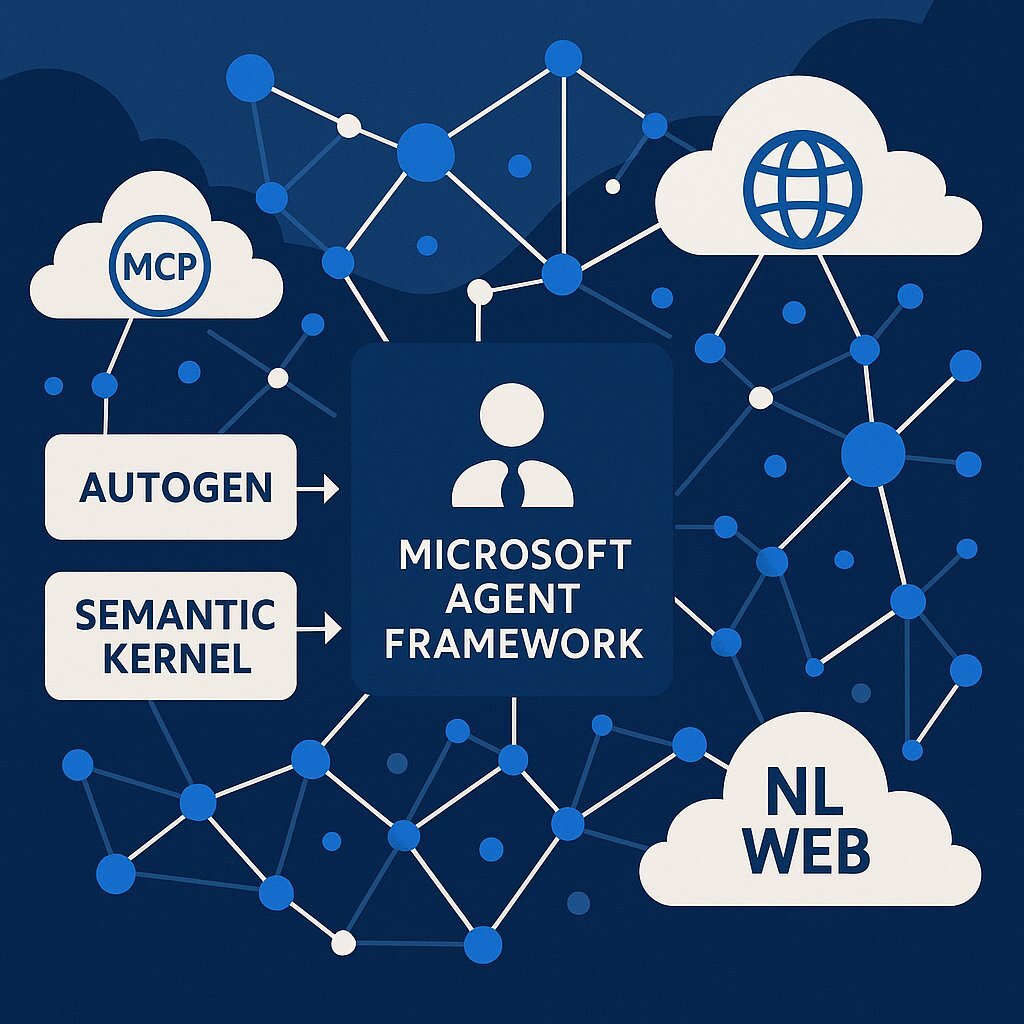
This new framework is being built for a grander vision: the "Open Agentic Web" . This is Microsoft's plan to create the protocols for a new, agent-driven internet, built on two key open-source concepts:
- Model Context Protocol (MCP): Think of this as the "HTTP for agents." It's an open standard for agents to securely and scalably communicate and exchange context with each other. For a practical deep-dive on MCP, check out our detailed guide to revolutionizing AI integration with MCP.
- NLWeb: Think of this as the "HTML for agents." A new open project from Microsoft that makes it easy for any website to provide a rich, "conversational interface" for its data, making it agent-discoverable.
This vision moves us from in-company agent teams to a global, cross-company ecosystem. It means your AutoGen-built "Logistics Agent" will be able to securely talk to your supplier's "Inventory Agent" (running NLWeb) using MCP, which then triggers a "Shipping Agent" from a third-party. This is the beginning of autonomous, "agentic" value chains.
Our Final Analysis: Is AutoGen Right for Your Business?
Here's the bottom line:
Microsoft AutoGen is one of the most powerful and flexible multi-agent frameworks available, backed by the full force of Microsoft Research and Azure.
Its strength is its flexibility for solving complex, exploratory problems . It shines in R&D, autonomous software development, and deep data analysis where the path to the solution is unknown.
It is less suited for simple, linear, or high-volume, low-latency tasks. For those, a simpler framework like CrewAI or even a bespoke, high-performance solution might be a better fit.
From Prototype to Production: The Baytech Perspective
The shift to multi-agent AI is happening, and the barrier to entry is lowering. But moving from an impressive demo to a secure, reliable, scalable enterprise application is a massive engineering leap.
This is where a partner with full-stack, enterprise-grade experience becomes essential. At Baytech Consulting, our "Tailored Tech Advantage" means we provide exactly that. Our highly skilled engineers have deep, hands-on experience in the entire stack that makes AutoGen work:
- The Data Layer: We are experts in the PostgreSQL and SQL Server databases where your critical data lives.
- The DevOps Pipeline: We build and manage CI/CD workflows using Azure DevOps On-Prem and VS Code/VS 2022 .
- The Infrastructure Layer: We deploy these applications on secure, scalable infrastructure, whether it's Azure , OVHCloud , or on-prem Harvester HCI managed with Rancher and Kubernetes . Learn more about our modern DevOps efficiency services.

If you are a CTO, CFO, or strategic leader ready to explore how a multi-agent solution can create a durable competitive advantage, let's talk. We can help you build a proof-of-concept that delivers real value, on time.
Frequently Asked Questions (FAQ)
Q: Can I integrate AutoGen with my existing CI/CD pipeline, like Azure DevOps?
A: This is a critical question for any enterprise adoption, and the answer is an emphatic yes .
First, AutoGen is fundamentally Python or .NET code. Like any other application, your agent definitions and custom tool logic must be stored in version control (like Git). From there, a standard Azure DevOps Pipeline can be used for continuous integration (CI) to automatically build, run unit tests, and package your agent application for deployment.
Second, and more importantly, the future of AutoGen (the new, unified Microsoft Agent Framework ) is being built explicitly for this. Microsoft has stated that it "integrates directly into GitHub Actions and Azure DevOps pipelines, with telemetry flowing into Azure Monitor and Application Insights for enterprise-grade deployment and root-cause analysis". This confirms that CI/CD and DevOps are a first-class priority for Microsoft's agent strategy.
Q: How does AutoGen handle data security and compliance in enterprise environments?
A: Microsoft AutoGen is designed with enterprise-grade security in mind, part of the Microsoft compliance ecosystem. While the core AutoGen framework is open source, enterprise deployments can use Azure OpenAI Service , which has encryption at rest and in transit, network isolation through Virtual Networks, and compliance with SOC 2, ISO 27001, and HIPAA . AutoGen’s architecture also has custom tool sandboxes and controlled code execution environments (via Docker or Azure Container Apps) to prevent access to sensitive data. For organizations with strict governance policies, AutoGen integrates with Azure Key Vault for secrets management and Azure Monitor for full telemetry visibility.
Q: Can AutoGen integrate with existing business applications like Dynamics 365, Salesforce, or custom CRMs?
A: Yes. AutoGen has tool-based integration , agents can use APIs from any enterprise system. Through the UserProxyAgent, AutoGen agents can call authenticated REST endpoints or interact with SDKs, so you can connect to business-critical systems like Dynamics 365 , Salesforce , HubSpot , or custom CRMs. Microsoft’s roadmap for the Microsoft Agent Framework includes native connectors for Dynamics 365, Power Automate, and Teams , so AutoGen-based agents can act as intelligent extensions of existing workflows — not just isolated prototypes.
Q: What kind of development expertise is required to build with AutoGen?
A: AutoGen is for experienced developers and technical innovators who know Python or .NET, as those are the only languages supported today. The new AutoGen Studio reduces the learning curve by providing a low-code interface for composing and debugging multi-agent systems without deep programming knowledge. But deploying production-grade agent systems still requires knowledge of DevOps, container orchestration (e.g., Kubernetes), and API integrations . Organizations with existing software teams — especially those already using Azure, .NET Core, or Python — will find it easy to adopt. For teams without that infrastructure, working with an implementation partner with a strong track record in support and maintenance ensures enterprise scalability, security, and ROI.
Supporting Reading on Multi-Agent LLM Systems
- AutoGen: Enabling Next-Gen LLM Applications via Multi-Agent Conversation
arXiv preprint (v2 revised Oct 3, 2023). Foundational paper describing the AutoGen framework and multi-agent conversation patterns. - AutoGen v0.4: Reimagining the foundation of agentic AI for scale, extensibility, and robustness
Microsoft Research blog (Jan 14, 2025). Major redesign introducing an event-driven architecture, observability, extensions, and cross-language support. - Introducing AutoGen Studio: A low-code interface for building multi-agent workflows
Microsoft Research blog (Jun 17, 2024). Low-code UI for composing, testing, and deploying multi-agent workflows on top of AutoGen. - Microsoft Agent Framework overview
Microsoft Learn. Product documentation outlining concepts, architecture, and capabilities of Microsoft’s Agent Framework. - AI Agents in Azure Database for PostgreSQL
Microsoft Learn. How to build and run generative-AI agents close to your data in Azure Database for PostgreSQL Flexible Server.
About Baytech
At Baytech Consulting, we specialize in guiding businesses through this process, helping you build scalable, efficient, and high-performing software that evolves with your needs. Our MVP first approach helps our clients minimize upfront costs and maximize ROI. Ready to take the next step in your software development journey? Contact us today to learn how we can help you achieve your goals with a phased development approach.
About the Author

Bryan Reynolds is an accomplished technology executive with more than 25 years of experience leading innovation in the software industry. As the CEO and founder of Baytech Consulting, he has built a reputation for delivering custom software solutions that help businesses streamline operations, enhance customer experiences, and drive growth.
Bryan’s expertise spans custom software development, cloud infrastructure, artificial intelligence, and strategic business consulting, making him a trusted advisor and thought leader across a wide range of industries.


